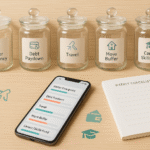If you’ve ever set a goal on Sunday and watched it fizzle by Wednesday, you’re not alone. The problem usually isn’t ambition—it’s architecture. The right structure can turn willpower into a system, and that system can transform your mindset from “I hope this happens” to “Here’s how I make it happen.” In this in-depth guide, you’ll learn the top 5 goal setting techniques to transform your mindset, with step-by-step instructions, beginner-friendly tweaks, common pitfalls, and a simple 4-week plan to help you start strong and keep going.
Who this is for: professionals, students, creators, and entrepreneurs who want practical frameworks (not fluff) and measurable results.
What you’ll learn: how to pick the right goals, translate them into daily action, and build the feedback loops that nudge you forward—even on low-motivation days.
Key takeaways
- Structure beats motivation. Systems like SMART, implementation intentions, WOOP, habits, and OKRs turn vague wishes into repeatable actions with built-in feedback.
- Make success easier to start and harder to ignore. Clear triggers, tiny first steps, and visible scorekeeping dramatically raise follow-through.
- Plan for obstacles before they show up. “If-then” plans and WOOP convert setbacks into cues for action instead of reasons to quit.
- Track what matters. Recording progress (privately or publicly) accelerates achievement and keeps your mindset focused on learning, not just outcomes.
- Pace yourself. Ambitious goals are great—just use safeguards against overload, tunnel vision, and burnout.
1) SMART (and Slightly Stretch) Goals: Turn Vague Wishes into Executable Targets
What it is & why it works
SMART goals are Specific, Measurable, Achievable, Relevant, and Time-bound. They transform fuzzy desires into concrete targets and create a built-in test for success. Pairing a SMART goal with a small stretch (ambitious but realistic) helps you think bigger without drifting into fantasy. Research over decades shows that specific, challenging goals guide attention, increase effort, and improve performance compared with “do your best” intentions.
Requirements / prerequisites
- A notebook or doc; any simple task manager or spreadsheet.
- Optional: timer app; calendar; habit tracker.
- Free or low-cost alternatives: paper index cards, a wall calendar, or a simple notes app.
Step-by-step setup for beginners
- Start with a direction. “Get fit,” “grow revenue,” “learn data analysis.”
- Make it SMART. “Jog 3x/week for 25 minutes; finish a 5K in 10 weeks.”
- Add a 10–20% stretch. If comfortable with 25 minutes, aim for 28–30 by Week 6.
- Define success and evidence. “By Oct 30, run 5K under 32:00.”
- Name the stakes. Why it matters to you now.
- Block time. Put sessions on your calendar as recurring events.
Beginner modifications & progressions
- Simplify: If a weekly target feels heavy, cut it in half and stack wins for two weeks.
- Progression: Once you hit your target 2–3 weeks straight, increase volume or difficulty by 10–15%.
Recommended frequency / metrics
- Cadence: Weekly review; daily checkmarks.
- KPIs: Binary completion (did/didn’t), leading metrics (time practiced, reps), and lagging metrics (test scores, deadlines met).
Safety, caveats & common mistakes
- Too many goals at once. Cap at 1–3.
- Unrealistic deadlines. Ambition is good; delusion burns you out.
- Outcome obsession. Balance outcome goals with process goals (e.g., minutes studied).
Mini-plan example (career):
- This week: Update résumé; list 20 target companies.
- By Friday 5 p.m.: Send 5 tailored applications; book 2 informational chats.
2) Implementation Intentions (“If-Then” Plans): Automate Your Next Move
What it is & why it works
Implementation intentions are if-then rules that tie a specific situation to a pre-decided action: If it’s 7:00 a.m., then I will start my 15-minute walk. These rules reduce decision friction, help you start faster, and protect your attention when distractions strike.
Requirements / prerequisites
- A list of critical moments and the tiny actions that fit them.
- Sticky notes or a simple notes app to keep rules visible.
- Optional: phone alarms for time-based triggers.
Step-by-step setup for beginners
- Identify 2–3 high-leverage moments when you tend to drift (after lunch, post-work slump, morning routine).
- Write precise if-then rules.
- If I make coffee, then I read one page of my exam notes.
- If I sit at my desk after lunch, then I draft three bullet points for the report.
- Attach a tiny first step. Keep the bar low (1 minute, 1 paragraph, 1 email).
- Add “distraction plans.”
- If a Slack DM pops up, then I finish my current bullet before checking.
- Review weekly; prune and refine.
Beginner modifications & progressions
- Micro-start: 30-second version for days you’re slammed.
- Progression: Chain rules together: If I finish the first paragraph, then I outline the second.
Recommended frequency / metrics
- Cadence: Daily use; weekly audit of which rules fired.
- KPIs: Rule activation rate (% times the “if” led to the “then”); streak length.
Safety, caveats & common mistakes
- Vague triggers. “When I feel ready” is not a trigger. Use time, place, or event.
- Oversized actions. If a rule takes >5 minutes to start, shrink it.
Mini-plan example (wellness):
- If I press the kettle button at 7:00 a.m., then I stretch calves for 60 seconds.
- If I close my laptop at 6:00 p.m., then I prep tomorrow’s lunch for 5 minutes.
3) WOOP (Wish-Outcome-Obstacle-Plan): Train Your Brain to Anticipate and Adapt
What it is & why it works
WOOP blends mental contrasting (imagining the desired outcome, then contrasting it with present obstacles) and implementation intentions (the plan). It’s powerful because it calibrates optimism with reality: you visualize the win, and you rehearse what you’ll do when things get in the way. That pairing improves commitment, follow-through, and time management, and it beats positive thinking alone.
Requirements / prerequisites
- 10 quiet minutes; pen and paper or notes app.
- Optional: a dedicated WOOP template.
Step-by-step setup for beginners
- Wish (W): Name a meaningful, feasible goal for the next 4–8 weeks.
- Outcome (O): Vividly picture what success looks and feels like.
- Obstacle (O): Identify the internal obstacle most likely to block you (e.g., “evening fatigue,” “scrolling”).
- Plan (P): Create a specific if-then: If I feel too tired to study at 8 p.m., then I’ll do a 3-minute walk, pour water, and start with one flashcard.
- Rehearse once daily for a week; update obstacles as you learn.
Beginner modifications & progressions
- One obstacle at a time. Start with your biggest internal blocker.
- Progression: Add a second obstacle after you’re consistent for 10–14 days.
Recommended frequency / metrics
- Cadence: New WOOP weekly; 60-second daily mental rehearsal.
- KPIs: Sessions started despite obstacles; days rescued by your WOOP plan.
Safety, caveats & common mistakes
- Externalizing blame. Focus on controllable, internal obstacles first.
- Skipping the “feel it” step. The emotional vividness of the outcome is fuel.
Mini-plan example (study):
- Wish: Pass accounting exam with ≥80%.
- Outcome: Relief and confidence at results.
- Obstacle: Procrastination after dinner.
- Plan: If it’s 8:15 p.m. and I haven’t started, then I open Anki and do 10 cards before anything else.
4) Systems & Habit Goals: Make Progress Automatic (and Enjoyable)
What it is & why it works
Goals set your direction; systems and habits carry you there. A behavior happens when Motivation, Ability, and a Prompt converge. That means the easiest way to change consistently is to simplify the action and engineer reliable prompts, not to wait for motivation. Repetition under stable cues gradually makes the behavior more automatic over time.
Requirements / prerequisites
- A stable cue (time/place/activity), a tiny starter action, and a prompt (alarm, visual cue).
- Optional: habit tracker; wall calendar; wearable reminders.
- Free: paper checklist; sticky notes; phone timer.
Step-by-step setup for beginners
- Pick a cue you already do daily. “After I brush my teeth…”
- Design a tiny starter. 1 push-up, 1 stanza, 1 line of code, 1 minute of budgeting.
- Add a prompt. Alarm, sticky note, or app notification.
- Celebrate immediately. A quick smile, “done!” tick—sounds trivial; it cements identity.
- Protect the chain. If you miss, never twice; do a micro-version to keep momentum.
Beginner modifications & progressions
- Tiny-first approach: Keep it absurdly small for 1–2 weeks.
- Progression: Increase duration or difficulty by 10–15% once the tiny action feels automatic.
Recommended frequency / metrics
- Cadence: Daily or near-daily for the smallest viable action.
- KPIs: Streak length; % of days with at least the tiny action; average session length; “friction notes” (what made it hard/easy).
Safety, caveats & common mistakes
- Starting too big. Big bursts are motivating but fragile.
- No prompt. Without a cue, even strong intentions evaporate.
- All outcome, no identity. Add identity statements: “I’m the kind of person who…” to shift mindset.
Make it enjoyable: temptation bundling
Pair a “should” behavior with a “want” reward: listen to your favorite audiobook only while walking, study with a special coffee, or save your best playlist for the gym. Field experiments show this nudge boosts adherence meaningfully.
Mini-plan example (writing):
- Cue: After morning coffee.
- Action: Write 50 words minimum.
- Reward: Favorite playlist while writing (only then).
5) Personal OKRs & Weekly Scorekeeping: Align Focus with Outcomes
What it is & why it works
OKRs—Objectives and Key Results—help you align focus (the Objective) with measurable outcomes (the Key Results). They work beautifully for personal goals when trimmed to a realistic scope. The Objective is qualitative and inspiring; KRs are numeric (what you can count). Reviewed weekly, OKRs create a crisp feedback loop that keeps your mindset oriented toward execution over wishful thinking.
Requirements / prerequisites
- One page—paper or digital.
- A weekly review slot (30–45 minutes).
- Optional: spreadsheet or goals app; calendar reminders.
Step-by-step setup for beginners
- Choose one quarterly Objective. “Ship a polished portfolio that wins interviews.”
- Define 2–4 Key Results.
- Publish 6 case studies by Nov 15.
- Apply to 30 roles; secure 6 interviews.
- Present 2 projects to peers for feedback.
- Add week-by-week lead indicators. “Draft one case study/week.”
- Score weekly. 0.0–1.0 per KR (e.g., 0.7 = 70% to plan); adjust tasks accordingly.
- Retrospective every 4 weeks. What to start/stop/continue?
Beginner modifications & progressions
- Start with one Objective. Add another only if the first runs smoothly.
- Progression: Increase KR ambition next quarter if you consistently hit 0.7–0.8+.
Recommended frequency / metrics
- Cadence: Weekly scoring; mid-quarter check; quarter-end grading.
- KPIs: KR completion rate; leading indicator adherence; tasks completed on schedule.
Safety, caveats & common mistakes
- Too many KRs. Keep it to 2–4.
- Gaming the numbers. Use KRs to learn, not to punish.
- Tunnel vision. Balance outcome KRs (results) with input KRs (behaviors) to prevent shortcuts.
Mini-plan example (health):
- Objective: Build sustainable cardio endurance.
- KRs: 3 cardio sessions/week for 12 weeks; complete a 5K in under 32:00 by the end; resting HR down by ~5 bpm.
- Weekly: Schedule sessions; log times and heart rate; review on Sunday.
Quick-Start Checklist (10 minutes)
- Pick one primary goal for the next 4–8 weeks.
- Write a SMART + stretch version of it.
- Add two if-then rules for the most likely obstacle moments.
- Do a 3-minute WOOP to rehearse your response to resistance.
- Design a tiny daily habit (≤2 minutes) tied to a reliable cue.
- Draft one mini OKR with 2–3 numeric Key Results.
- Choose your tracking method (paper calendar, spreadsheet, notes app).
- Book a 15-minute weekly review on your calendar right now.
Troubleshooting & Common Pitfalls
- “I miss one day and spiral.”
- Solution: Adopt the “never twice” rule. Micro-version counts.
- Mindset: Treat your plan like a scientist treats an experiment—data, not drama.
- “My trigger doesn’t trigger.”
- Solution: Swap to a time- or place-based cue you never miss (e.g., after teeth brushing).
- “I have too many goals.”
- Solution: Use a parking lot list. Keep 1–3 active goals; everything else waits.
- “I’m busy; the plan is heavy.”
- Solution: Shrink to two-minute wins and one weekly block (non-negotiable).
- “I lose motivation mid-project.”
- Solution: Re-WOOP; add a temptation bundle; make progress visible.
- “I’m anxious about results.”
- Solution: Add process KRs (minutes practiced, drafts made) to balance outcome pressure.
- “My goals feel arbitrary.”
- Solution: Tie each goal to a value (“Why now?”). Relevance fuels resilience.
- “I get perfectionistic.”
- Solution: Pre-write a “good enough” definition and ship to that.
How to Measure Progress (So Your Mindset Gets Stronger)
- Binary streaks: Did you show up today? Yes/No. This builds identity.
- Leading indicators: Minutes practiced, pages drafted, outreach attempts. These are controllable.
- Lagging indicators: Test scores, revenue, race times. Review monthly/quarterly.
- Rule activation rate: What % of your if-then rules actually fired?
- KR score (0.0–1.0): Numeric grade for weekly OKR progress.
- Reflection prompts (weekly):
- What moved the needle?
- What friction did I meet, and how will I pre-plan for it next week?
- What tiny improvement will I test?
Recording progress—especially when you write it down or report it—strengthens commitment and improves outcomes. Build that into your system from day one.
A Simple 4-Week Starter Plan (Mindset + Mechanics)
Week 1 — Foundations & Friction-Proofing
- Draft one SMART + stretch goal and one mini OKR (2–3 KRs).
- Write two if-then rules for your biggest obstacle times.
- Design a tiny habit (≤2 minutes) tied to a rock-solid cue.
- Do a full WOOP and rehearse it 60 seconds daily.
- Track daily in a simple grid (date, showed up, tiny action done).
- Weekly review (15 min): What worked, what didn’t, what to tweak.
Week 2 — Stability & Visibility
- Keep the tiny habit daily; maintain “never twice.”
- Add one temptation bundle to make practice pleasant.
- Make progress visible (paper calendar X’s or a digital streak).
- Refine if-then rules; add one “distraction plan.”
- Weekly review: Score KRs (0.0–1.0); adjust your plan.
Week 3 — Small Stretch & Feedback
- Increase difficulty by 10–15% if you’ve been ≥80% consistent.
- Share a public check-in (with a friend or small group) if comfortable.
- Run a WOOP refresh targeting the new friction you discovered.
- Weekly review: Note one learning and one change to test next week.
Week 4 — Consolidate & Commit
- Keep cadence; avoid adding new goals.
- Conduct a mini-retrospective: Start/Stop/Continue.
- Decide on the next 4-week cycle (same goal, leveled up; or a new one).
- Celebrate progress and copy forward your best rules and prompts.
Frequently Asked Questions
1) How many goals should I pursue at once?
Start with one primary goal (max three). Fragmentation kills momentum. You can keep a “parking lot” for ideas you’ll tackle later.
2) Do I need to write goals daily?
Daily writing is optional. What matters most is clarity up front (SMART + OKRs), visible tracking, and a weekly review habit.
3) What if I don’t know my “why”?
Pick a provisional why and run a 4-week experiment. Clarity often comes from action. Revisit your why at each review.
4) I struggle with consistency. What should I change first?
Shrink the action to a two-minute version, tie it to a reliable cue, and add a visual streak. Use “never twice” to bounce back.
5) Can I set two different goals in different life areas?
Yes—if the total load is realistic. For example, one work OKR and one tiny daily wellness habit. Review both weekly.
6) How do I avoid burnout?
Cap active goals, schedule recovery blocks, balance outcomes with process KRs, and build WOOP plans that include rest.
7) How do I deal with distractions?
Pre-plan if-then rules for common triggers (notifications, snacks, social). Keep your rules visible on your desk or phone.
8) What if my goal depends on other people?
Shift your KRs toward controllable inputs (outreach sent, demos scheduled) and skill development you own.
9) How long does it take to build a habit?
It varies widely by person and behavior. Expect weeks to months, and treat early repetition as especially valuable.
10) Are OKRs only for companies?
No. A single, clear personal Objective with 2–3 Key Results provides focus and measurable feedback at home, school, or work.
11) Should I keep goals private or share them?
Either works, but recording and (when appropriate) reporting progress can boost follow-through. Choose the audience that supports you.
12) What if goal setting stresses me out?
Use gentler process goals, shorter cycles (2–4 weeks), and identity statements (“I’m the kind of person who shows up”). If stress persists, downshift scope.
Conclusion
Mindset transformation isn’t mystical; it’s mechanical. The five techniques you’ve learned—SMART + stretch goals, if-then plans, WOOP, habit systems, and personal OKRs—give you a playbook to start immediately, recover quickly, and grow deliberately. When you stack these tools, you shift from hoping to engineering progress. Four weeks from now, your calendar, your notes, and your results can tell a very different story.
CTA: Pick one goal, write one if-then rule, and take your two-minute action today.
References
- Building a Practically Useful Theory of Goal Setting and Task Motivation: A 35-Year Odyssey, American Psychologist, September 2002. URL: https://pubmed.ncbi.nlm.nih.gov/12237980/
- New Directions in Goal-Setting Theory, Association for Psychological Science (PDF), 2006. URL: https://www.lyondellbasell.com/4930f1/globalassets/sustainability/lifebeats/advancing-health/life/goals/newdirectioningoalsetting_locke-et-al..pdf
- There’s a S.M.A.R.T. Way to Write Management’s Goals and Objectives, Management Review, November 1981. URL: https://community.mis.temple.edu/mis0855002fall2015/files/2015/10/S.M.A.R.T-Way-Management-Review.pdf
- Implementation Intentions: Strong Effects of Simple Plans, American Psychologist, 1999 (PDF via University of Konstanz). URL: https://kops.uni-konstanz.de/bitstreams/14cc2a36-5f01-4dc1-b9ca-f2d0ca0c8930/download
- Does Monitoring Goal Progress Promote Goal Attainment? A Meta-Analysis, Psychological Bulletin, 2016 (PubMed). URL: https://pubmed.ncbi.nlm.nih.gov/26479070/
- Modeling Habit Formation in the Real World, European Journal of Social Psychology, 2010 (Wiley). URL: https://onlinelibrary.wiley.com/doi/abs/10.1002/ejsp.674
- Fogg Behavior Model: How Behavior Works (website, n.d.). URL: https://www.behaviormodel.org/
- Prompts in the Fogg Behavior Model (website, n.d.). URL: https://www.behaviormodel.org/prompts
- Holding the Hunger Games Hostage at the Gym: An Evaluation of Temptation Bundling, Management Science, 2014 (PMC). URL: https://pmc.ncbi.nlm.nih.gov/articles/PMC4381662/
- Teaching Temptation Bundling to Boost Exercise: A Field Experiment, Journal of Economic Behavior & Organization, 2020. URL: https://www.sciencedirect.com/science/article/pii/S074959782030385X
- Mental Contrasting with Implementation Intentions (MCII) Improves Academic Performance in Children, Social Psychological and Personality Science, 2011 (PMC). URL: https://pmc.ncbi.nlm.nih.gov/articles/PMC4106484/
- Mental Contrasting with Implementation Intentions and Time Management, European Journal of Social Psychology, 2015 (PDF). URL: https://www.socmot.uni-konstanz.de/sites/default/files/Oettingen_et_al-2015-European_Journal_of_Social_Psychology_0.pdf
- Strategies of Setting and Implementing Goals: Mental Contrasting and Implementation Intentions (book chapter PDF), 2010. URL: https://www.psy.uni-hamburg.de/arbeitsbereiche/paedagogische-psychologie-und-motivation/personen/oettingen-gabriele/dokumente/oettingen-gollwitzer-2010.pdf
- What Is an OKR? Definition and Examples (What Matters website, n.d.). URL: https://www.whatmatters.com/faqs/okr-meaning-definition-example
- OKRs Explained (What Matters website, n.d.). URL: https://www.whatmatters.com/okrs-explained/
- Goals Gone Wild: The Systematic Side Effects of Over-Prescribing Goal Setting, Academy of Management Perspectives, 2009 (HBS PDF). URL: https://www.hbs.edu/ris/Publication%20Files/09-083.pdf






